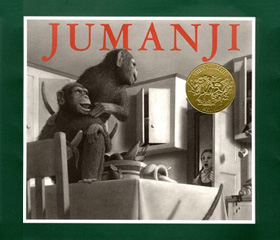
Book Summary:
This picture book centers around Oliver who is a little different than everyone else. Oliver enjoys playing with his friends, which are his puppets, and going on adventures with them in his imagination. However, Oliver feels lonely, and when he ends up playing tennis with himself he finds someone else who is a bit different too.
APA Reference of Book:
Sif, B. (2012). Oliver. Somerville, MA: Candlewick Press.
Impressions:
I loved this book. It is possibly my favorite picture book I have ever read. It is such a simple message but I felt that it was very well done. The illustrations matched the book in color as well as character design. The message to me is it is okay to be different, and that does not mean you are alone. I like that in the end he met a girl who was a little different, but she was in all of the illustrations where Oliver is in public places. I feel like I could look at these illustrations for hours with all of the little details that you may not have noticed the first read through. For instance, in the library illustration there is a mouse reading a book in one of the book shelves, and with another reading you notice the mouse is in all of the other illustrations. I also liked the creative way the text was written when the tennis ball bounced. This was a lovely book and I definitely want my own copy. It is a very sweet book.
Professional Review:
"The Book Review: Preschool to Grade 4: Fiction
Oliver SIF, Birgitta. illus. by author. 40p. Candlewick. 2012. RTE $16.99. ISBN 978-0-7636-6247-9.
PreS-Gr 1-A rhythmic narrative introduces bespectacled Oliver,
a child who "felt a bit different" and prefers the company of his
stuffed animals, puppets, and a mouse to that of other children. He and
his "friends" have grand, imaginary adventures together, often oblivious
to the many other people around them. Even so, his solitude is
underscored when he swims in the pool alone and when he discovers that
his pretend companions aren't necessarily interested in listening to him
play the piano. Then, Oliver's
tennis ball, which he hits against the wall of his house, bounces into
the neighbor's yard where he meets Olivia, also "a bit different." The
two children discover the pleasure of lobbing the tennis ball to each
other over a clothesline-and the "best adventure" of Oliver's
new friendship begins. Whimsical pencil illustrations, digitally
colored in a palette of subdued greens, blues, lavenders, and browns,
evoke Oliver's surroundings and his own idiosyncrasies in humorous detail. While the story line starts out engagingly enough, Oliver's
development into a more companionable youngster is thin and rather
arbitrary. Still, paired with Peter Reynolds's I'm Here (S & S,
2011), this picture book could be a useful tool to engender discussion
about human differences and the satisfaction of friendship, especially
for those who are shy or feel "a bit different." "
(Finn, 2012
Finn, K. (2012). [Review of the book Oliver, by K. Finn]. School Library Journal, 58(11), 84. Retrieved from http://www.slj.com
Library Uses:
I think this would be a great story to read to a classroom. I think it is important for children to know that it is okay to be different.
